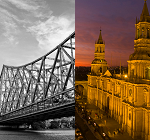A distance of 17,789 kilometres separates Kolkata in India from Arequipa, Peru’s second-largest city, and few in either place know of the existence of the other. Yet, commonalities could make them twins. Both have a rich literary culture and embedded intelligentsia; they are the birthplace of Rabindranath Tagore and Mario Vargas Llosa respectively, the only Nobel laureates in literature from either country. Many colourful auto rickshaws in Kolkata and mototaxis in Arequipa are made by the same company – Bajaj. Some even share the same instruction label on how to use the three-wheeler’s steering wheel – written in Hindi. Echoes of Indian songs like “Bole chudiyan, bole kangna,” reverberate in remote corners of the vast Andes mountain range that surrounds Arequipa, in southern Peru. Not only is Bollywood music popular, but every second Arequipeño is familiar with Rishi Kapoor’s debut film Mera Naam Joker. The greatest point of convergence though, is probably Kolkata’s Mother Teresa, who goes by the Spanish name of Madre Teresa de Calcuta in all of Peru. Yet, few there recognize that Calcuta is in India.
This article was first published by Gateway House: Indian Council on Global Relations, here.


